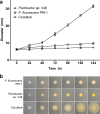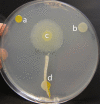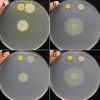Interspecies Social Spreading: Interaction between Two Sessile Soil Bacteria Leads to Emergence of Surface Motility
- PMID: 30700513
- PMCID: PMC6354810
- DOI: 10.1128/mSphere.00696-18
Interspecies Social Spreading: Interaction between Two Sessile Soil Bacteria Leads to Emergence of Surface Motility
Abstract
Bacteria often live in complex communities in which they interact with other organisms. Consideration of the social environment of bacteria can reveal emergent traits and behaviors that would be overlooked by studying bacteria in isolation. Here we characterize a social trait which emerges upon interaction between the distantly related soil bacteria Pseudomonas fluorescens Pf0-1 and Pedobacter sp. strain V48. On hard agar, which is not permissive for motility of the monoculture of either species, coculture reveals an emergent phenotype that we term "interspecies social spreading," where the mixed colony spreads across the hard surface. We show that initiation of social spreading requires close association between the two species of bacteria. Both species remain associated throughout the spreading colony, with reproducible and nonhomogenous patterns of distribution. The nutritional environment influences social spreading: no social behavior is observed under high-nutrient conditions, but low-nutrient conditions are insufficient to promote social spreading without high salt concentrations. This simple two-species consortium is a tractable model system that will facilitate mechanistic investigations of interspecies interactions and provide insight into emergent properties of interacting species. These studies will contribute to the broader knowledge of how bacterial interactions influence the functions of communities they inhabit.IMPORTANCE The wealth of studies on microbial communities has revealed the complexity and dynamics of the composition of communities in many ecological settings. Fewer studies probe the functional interactions of the community members. Function of the community as a whole may not be fully revealed by characterizing the individuals. In our two-species model community, we find an emergent trait resulting from the interaction of the soil bacteria Pseudomonas fluorescens Pf0-1 and Pedobacter sp. V48. Observation of emergent traits suggests there may be many functions of a community that are not predicted based on a priori knowledge of the community members. These types of studies will provide a more holistic understanding of microbial communities, allowing us to connect information about community composition with behaviors determined by interspecific interactions. These studies increase our ability to understand communities, such as the soil microbiome, plant-root microbiome, and human gut microbiome, with the final goal of being able to manipulate and rationally improve these communities.
Keywords: Pseudomonas fluorescens; interspecies interaction; motility; sociomicrobiology.
Copyright © 2019 McCully et al.
Figures







Similar articles
-
Exploration of Social Spreading Reveals That This Behavior Is Prevalent among Pedobacter and Pseudomonas fluorescens Isolates and That There Are Variations in the Induction of the Phenotype.Appl Environ Microbiol. 2021 Sep 10;87(19):e0134421. doi: 10.1128/AEM.01344-21. Epub 2021 Jul 21. Appl Environ Microbiol. 2021. PMID: 34288708 Free PMC article.
-
The effect of phylogenetically different bacteria on the fitness of Pseudomonas fluorescens in sand microcosms.PLoS One. 2015 Mar 16;10(3):e0119838. doi: 10.1371/journal.pone.0119838. eCollection 2015. PLoS One. 2015. PMID: 25774766 Free PMC article.
-
Transcriptional and antagonistic responses of Pseudomonas fluorescens Pf0-1 to phylogenetically different bacterial competitors.ISME J. 2011 Jun;5(6):973-85. doi: 10.1038/ismej.2010.196. Epub 2011 Jan 13. ISME J. 2011. PMID: 21228890 Free PMC article.
-
Bacterial social interactions and the emergence of community-intrinsic properties.Curr Opin Microbiol. 2018 Apr;42:104-109. doi: 10.1016/j.mib.2017.11.018. Epub 2017 Dec 1. Curr Opin Microbiol. 2018. PMID: 29197823 Review.
-
Life in earth - the root microbiome to the rescue?Curr Opin Microbiol. 2017 Jun;37:23-28. doi: 10.1016/j.mib.2017.03.005. Epub 2017 Apr 21. Curr Opin Microbiol. 2017. PMID: 28437662 Review.
Cited by
-
Delivering "Chromatic Bacteria" Fluorescent Protein Tags to Proteobacteria Using Conjugation.Bio Protoc. 2019 Apr 5;9(7):e3199. doi: 10.21769/BioProtoc.3199. eCollection 2019 Apr 5. Bio Protoc. 2019. PMID: 33654996 Free PMC article.
-
The State of the Union Is Strong: a Review of ASM's 6th Conference on Cell-Cell Communication in Bacteria.J Bacteriol. 2018 Jun 25;200(14):e00291-18. doi: 10.1128/JB.00291-18. Print 2018 Jul 15. J Bacteriol. 2018. PMID: 29760210 Free PMC article. Review.
-
Flower-like patterns in multi-species bacterial colonies.Elife. 2020 Jan 14;9:e48885. doi: 10.7554/eLife.48885. Elife. 2020. PMID: 31933477 Free PMC article.
-
Pseudomonas aeruginosa surface motility and invasion into competing communities enhance interspecies antagonism.mBio. 2024 Sep 11;15(9):e0095624. doi: 10.1128/mbio.00956-24. Epub 2024 Aug 6. mBio. 2024. PMID: 39105585 Free PMC article.
-
Sessile bacterium unlocks ability of surface motility through mutualistic interspecies interaction.Environ Microbiol Rep. 2021 Apr;13(2):112-118. doi: 10.1111/1758-2229.12911. Epub 2020 Nov 29. Environ Microbiol Rep. 2021. PMID: 33225572 Free PMC article.
References
-
- Blasche S, Kim Y, Oliveira AP, Patil KR. 2017. Model microbial communities for ecosystems biology. Curr Opin Syst Biol 6:51–57. doi:10.1016/j.coisb.2017.09.002. - DOI
Publication types
MeSH terms
Substances
LinkOut - more resources
Full Text Sources
Research Materials

